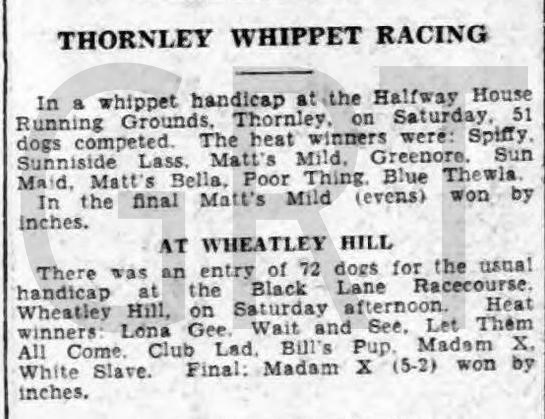Dunhelm Road, Thornley, County Durham.
POSTCODE————————————DH6 3GZ
LOCATED————————————–The village of Thornley is located roughly five miles south east of the city of Durham just off the A181. The site of the track lies one and a half miles west of Wheatley Hill Greyhound Stadium at the junction of the A181 and B1279 Denholm Road.
ORIGINAL SITE——————————-Farm Grazing Land, situated at the rear of the Halfway House Inn.
DATE CONSTRUCTED———————-During the early 1930’s.
DATE VENUE OPENED———————Early 1930’s for Whippet Racing.
Meaning other sports may have taken place prior to the arrival of Greyhound Racing.
FIRST MEETING——————————Possibly 1937.
Greyhound Racing only.
LICENSED OR INDEPENDENT————Independent
All venues covered would have to be licensed with the government, licensed suggested in this section would refer to tracks operating under NGRC Rules.
INSIDE OR OUTSIDE HARE TYPE——–Possibly a trackless ball hare system.
Please note that the Electric Hare suggested is only a guidance’, and would have been in operation for a certain amount of time at this venue. Although it is not necessarily guaranteed that it was operational all the time, as other types of lure may have been used and updated as time progressed.
DISTANCES————————————Not known.
Please note that most racing venues distances had become varied throughout the years, the ones given above were at once point set and offers only a guidence to the track size.
CIRCUMFERENCE—————————A pear shaped track, possibly a two bend affair.
Please note that alterations at most racing venues throughout its existence would see that the circumference of the track would vary, the one shown above offers only a guidance to the track size.
BIG RACE NAMES—————————None found.
STADIUM SHARED WITH——————Whippet Racing.
LAST MEETING——————————-Possibly during the 1960’s.
Greyhound Racing only.
STADIUM CLOSURE DATE—————-Don’t know.
Meaning other sports may have taken place after Greyhound Racing had ceased.
STADIUM DEMOLITION——————–Shown on 1966 map, but not the one from 1972.
BUILT ON SITE——————————–Originally the Crossways Hotel covered part of the site, but that was demolished in 2007 and became replaced by modern day housing found on the Crossways Estate, Thornley.
In some cases, structure’s that originally covered the venue after the stadium had been demolished, may have been themselves demolished too, so the one described is more likely to be the one which now presently covers the site.
EVIDENCE LEFT TODAY——————–Nothing known of.
FURTHER COMMENTS———————The entrance to the venue was behind the old Halfway House Inn. The Crossways Hotel replaced this public house during the late 1970’s. Incidentally The old Halfway House Inn was known as The Grapes during the mid nineteenth century.




Today’s greyhound stadium at Wheatley Hill is located in the North East of England, with the present day greyhound followers suggesting the neighbouring now closed Easington track could be more recognised as its nearest competitor. But unknown to many, there lay a track within one and a half miles west of the Wheatley Hill village. It was known as the Halfway House greyhound track, located in a small village of Thornley.
Thornley is an ex coal mining village, situated five miles south east of the City of Durham, one of a number of small mining villages scattered around the Durham moors. It was during the early 1930’s, that a section of grazing land situated at the rear of the Halfway House public house, began to experience the first forms of dog racing. It was the publican of The Halfway House that allowed whippets to race on the land, knowing full well that he would have excellent support from the local mining community.
By 1935 the fields which once occupied the straight whippet track, began to develop into a more recognised enclosed venue, even for whippet racing which continued right up until early 1937. It was at this period that greyhound racing was introduced, as it was becoming clear that the sport was becoming more appealing to the public than whippet racing did.
It began operations as an independent flapping track, with the track having developed into somewhat of a horseshoe shape, this due to the restricted size of available land. The tightness of the horseshoe shape track made it impossible to make the track into a complete circuit, restricting races to just two bend affairs only. A totalisator system was installed during 1938, but the system only operated up until the outbreak of the Second World War, seeing it failing miserably, and was never used again due to its unpopularity.
Greyhound racing continued up until the late 1960’s but ceased due to dwindling attendances. All outbuildings became removed with the rest of the site just disappearing into the undergrowth. Sadly even the Halfway House public house disappeared also, being replaced by the Crossways Hotel in 1977. By 2007 the Crossways Hotel became history also, as the land became required for the building of new housing.
A new housing estate known as the Crossways now covers the site along Dunhelm Road, leaving no trace of a venue that once hosted dog racing.
A programme, photograph or even memorabilia for this track is required for this page, if you can help please contact me.

Recent Comments